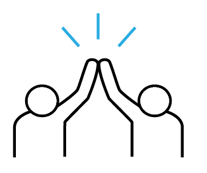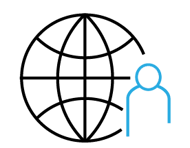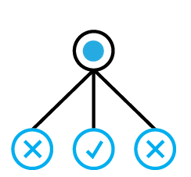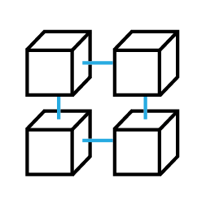23 Trends on Virtual Work for Leaders
Out of necessity comes re-invention. While many point to the pandemic as the catalyst for our Work From Anywhere World™, this current state of workplace fluidity was an eventuality. In fact, it is the culmination of a number of shifts already in play, delivering us into a new era, a new age. This article highlights those trends, offering leaders a fresh perspective to support what they decide to do next.
Initially, the trend of Work from Anywhere (WFA) was intriguing, but not wholeheartedly embraced – that is, until the global pandemic quickly emptied most office buildings. As some businesses tip-toed on the edge of WFA waters, COVID-19 plunged the rest of us over the edge and into a New Age of Work.
This plunge has forced us to make significant leaps in what we do, how we get things done, where we do them and our overall approach to personal workplace interactions.
There’s no turning back now.
For leaders within the SMB space, what began as a temporary fix in response to COVID-19 concerns may be quickly evolving into part of a long-term Workplace policy. Why? Working from anywhere is not going anywhere. In fact, the trend is the culmination of a series of other trends cascading to widespread WFA adoption. Add to that, vaccination inconsistencies and spikes of illness recurrence only fuel the need for organizations to revisit how people Work to adopt workplace policies that will support consistency and flexibility as we navigate uncertain times.
So, what are those trends and shifts that brought us to this point? Glad you asked (and let me know if you agree).
23 Trends About Work From Anywhere That SMB CEO's Need to Know
1. 
COVID-19 quarantines exposed millions of workers to Work From Anywhere™(WFA). Most of us stepped back and realized we didn’t have to put up with hour commutes or office politics or be chained to a desk or an airline to do our best Work.
2. 
Cloud-based technologies continue to improve, giving us the ability to WFA and better connect with others regardless of location.
3.
The decrease in physical presence leads to an increase in the desire to do meaningful Work and an increase in the need to matter.
4.
How we matter as individuals is complicated and ever evolving. To matter, deep down, people know this: We not only need to matter in order to matter, but that we need to be doing things that genuinely matter to us.
5. 
Deep, deep down most employees and leaders simply want to make life better, not just for themselves but for others, as we are social creatures.
6. 
The decrease in physical proximity has led to an increased need for trust, which requires an increased need for clear agreements (who we are, what we do, who we serve, why we do it the way we do it, where we are going, how fast we want to go, etc.).
7. 
The increased need for clear agreements leads to an increased need for technology to memorialize and align around them.
8. 
Once we identify those agreements, in a High Trust Workplace it's Almost Easy™ to increase a healthy level of visibility into what’s working and what’s not working within the organization.
9.
This increased understanding of what’s working and what’s not working leads to a greater understanding of competencies required, as well as the required level of behaviors, also known as character.
10.
The increased understanding of competencies, as well as the decrease in physical presence, leads to an increased need for personal connection, which leads to an increased need for coaching.
11. 
The increased need for coaching leads to an increased need for training and self-development.
12. 
The increased need for training and development to support Work From Anywhere leads to an increased need for technology enabled self-learning, including the understanding of self and others.
13. 
The ever increasing use of technology by all working members of society leads to an increased reliance on mobile as well as connectivity from (almost) anywhere.
14. 
This increased use of technology generates more useful data, as well as increased demand for data across the organization.
15. 
Our increasing interest in, and need for understanding, useful data will move us away from false information and toward becoming more and more reliant on and desirous of useful information and focusing on what matters. This trend toward valuing useful data and knowledge and questioning everything else will eventually spill into the public sector and start to ripple across the globe – a very good thing.
16. 
The increasing need to access the data across the organization further reinforces the need for whole company tools that provide transparency across all facets of the organization (e.g., Ninety.io).
17. 
Once we start using data more and more, we will see an increasing need for genuine connection– for people to believe we genuinely care - so our colleagues believe we are using the data to understand and explain and help them achieve their personal goals - not to monitor and control.
18. 
Once we see the increasing need for data and genuine connection, we will see the increasing need for consistent (e.g., weekly) meetings and honoring our commitments, and this will lead to an increasing need for chunking up how we work.
19. 
An increased need for chunking leads to an increased comfort with fractional work (i.e., “on-demand” workers, less than 40 hours per week) and WFA. Fractional work has been something that has been obvious for years but didn’t work well for a host of reasons. WFA and chunking increases the likelihood that it can make sense.
20. 
Increased comfort with fractional WFA work means that there will be increased opportunities for caregivers, those who want to stay at home to care for loved ones, but also Work.
21.
Increased comfort in WFA, chunking and fractional work will lead to an increased comfort with the “death of retirement,” which has huge implications for society. If a person truly loves their Work, why would they retire? They make money. They stay mentally and physically active. They get to Work from Anywhere.
22. 
Great companies that embrace WFA will be able to attract and retain great talent. Over time, crappy companies will lose their strong talent and struggle to attract and retain decent talent. In the long run, this is good for everyone.
23. 
As we move toward a society comprised of more and more great, high-trust, companies made up of individuals capable of high-trust relationships, we will see more and more people loving work, growing through work, working longer and living better. A true win-win-win-win! And is there anything better than a world filled with people who love their Work?
Within and among the most advanced societies and economies, Ages of Humans are defined by a quantum leap in either insights, tools, competencies, relationships and / or disciplines. Let’s be remembered for the leaps we took during these unusual times. Let’s explore even more opportunities to evolve our organizations, to move closer and closer toward Work that truly satisfies as it helps us become better and better versions of our best selves.
Do you have the right tools to support a semi-remote future?
If you're a leader who is considering a long-term transition to Work From Anywhere, who is seeking a whole company operating system to better support your teams to achieve everything you want for your organization, grab your trial of Ninety.io. See what you think.






